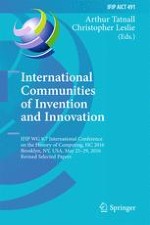This book contains revised selected papers presented at the IFIP WG 9.7 International Conference on the History of Computing, HC 2016, held in Brooklyn, NY, USA, in May 2016.
The 13 full papers included in this volume were carefully reviewed and selected from numerous submissions. The papers cover a wide range of topics related to the history of computing and focus on the history of pre-existing relationships and communities that led to triumphs (and dead-ends) in the history of computing. This broad perspective helps to tell a more accurate story of important developments like the Internet and provide a better understanding of how to sponsor future invention and innovation. They reflect on histories that foreground the international community along four broad themes: invention, policy, infrastructure, and social history.
